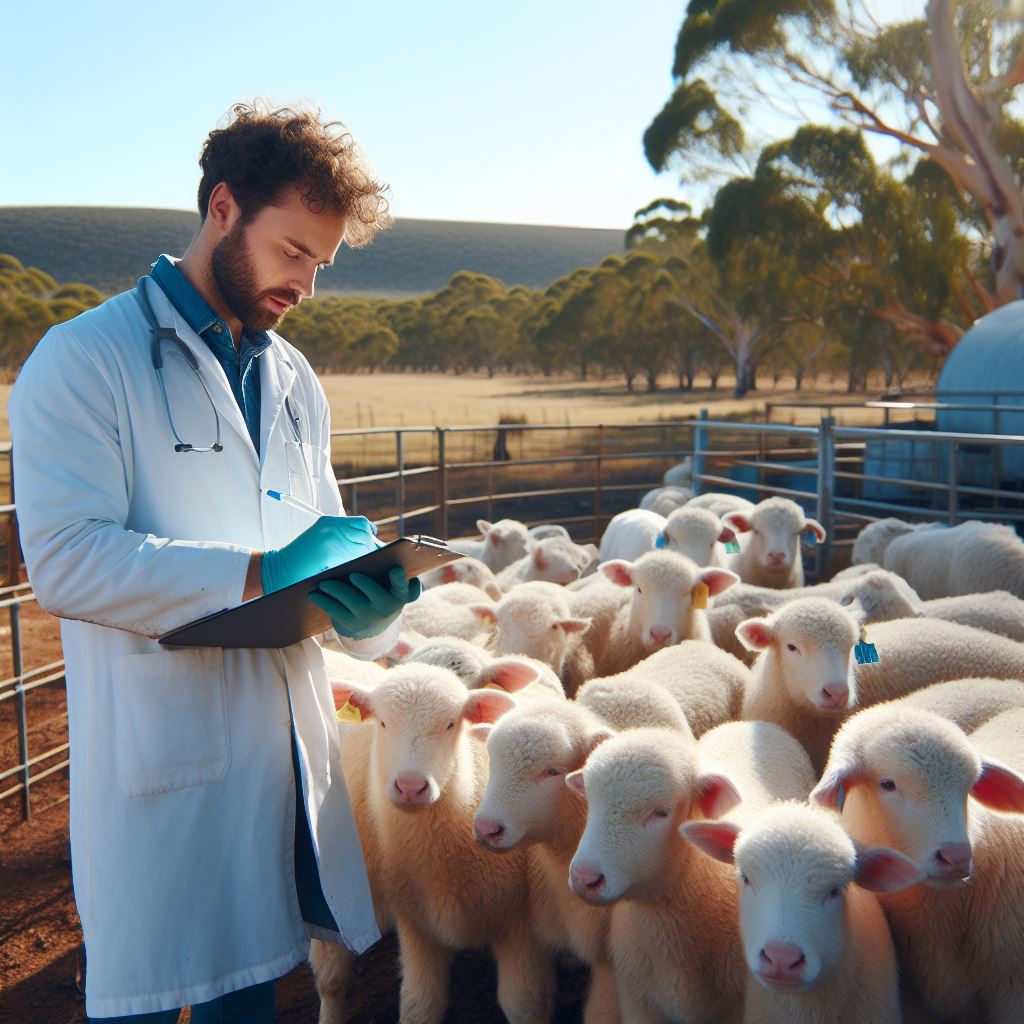Introduction
Aussie Agri Robots, which play a significant role in the agricultural industry, are worth discussing. Transitioning to the topic of Agri Robots’ role in future farming.
Agri Robots have revolutionized the agricultural industry with their advanced capabilities and automation.
These robots perform a range of tasks, such as planting, harvesting, and monitoring crops, with incredible precision.
Their significance lies in their ability to optimize efficiency, reduce labor costs, and increase overall productivity in farming operations.
Future farms see agri robots take center stage.
They will be crucial in addressing the challenges faced by the industry, such as labor shortages and environmental sustainability.
Agri Robots can work continuously without the need for breaks or rest, ensuring round-the-clock productivity.
With advanced sensors and artificial intelligence, these robots can analyze soil conditions, detect diseases, and apply treatments accurately.
By automating repetitive tasks, Agri Robots enable farmers to focus more on strategic decision-making and improving overall farm management.
Not only do they increase productivity, but Agri Robots also contribute to the reduction of chemical usage and soil erosion.
The future of farming will heavily rely on the integration of Agri Robots, providing sustainable solutions for long-term food production.
As technology continues to advance, these robots will become more agile, intelligent, and capable of handling complex farming tasks.
In review, Agri Robots have proven their significance in the agricultural industry and will continue to shape the future of farming, ensuring sustainable and efficient food production.
The Current State of Agriculture in Australia
In Australia, the agricultural sector plays a crucial role in the country’s economy and overall development.
The challenges faced by traditional farming methods in Australia are manifold. First and foremost, there is a constant pressure to increase productivity and yield while reducing labor costs.
Additionally, traditional farming practices are highly dependent on favorable weather conditions, which are becoming more unpredictable due to climate change.
Your Personalized Career Strategy
Unlock your potential with tailored career consulting. Get clear, actionable steps designed for your success. Start now!
Get StartedMoreover, traditional farming methods require a significant amount of water, which is already a scarce resource in many parts of Australia. This puts immense pressure on farmers to find alternative water sources or adopt more efficient irrigation techniques.
Another challenge faced by traditional farming methods is the need for manual labor. With an aging population and a decline in the number of people pursuing careers in farming, there is a shortage of skilled labor in the agricultural sector.
The need for innovative solutions
Given these challenges, there is an urgent need for innovative solutions in Australian agriculture.
One such solution is the use of agricultural robots, also known as agri-robots.
Agri-robots have the potential to revolutionize farming in Australia.
They can automate various tasks, such as planting seeds, monitoring crop health, applying pesticides, and harvesting crops.
By incorporating robotics and automation into farming practices, agri-robots can significantly increase productivity and yield.
Day or night, robots keep crops thriving, no breaks needed.
Moreover, agri-robots can operate in challenging weather conditions and terrains.
Robots conquer tough terrain, farmers win with bigger harvests.
The use of agri-robots also addresses the issue of labor shortage in the agricultural sector.
By automating repetitive tasks, farmers can reduce their dependence on manual labor and focus on more skilled and specialized roles.
Furthermore, agri-robots require less water compared to traditional farming methods.
With their precise irrigation systems and sensors, these robots can optimize water usage, leading to significant water savings and increased sustainability.
Overall, the adoption of agri-robots can lead to a more efficient and sustainable agricultural sector in Australia.
These robots have the potential to overcome the challenges faced by traditional farming methods and pave the way for a future of smart farming.
In short, the current state of agriculture in Australia is characterized by various challenges.
These challenges, such as labor shortage, water scarcity, and unpredictable weather conditions, call for innovative solutions.
Agri-robots offer a promising alternative, providing increased productivity, reduced labor dependency, and improved sustainability.
The future of Australian farming lies in embracing these technological advancements to ensure food security and economic prosperity.
Read: Climate Change Impact on Australian Farms
Introduction to Agri Robots
Agri Robots, also known as agricultural robots, are machines designed and programmed to perform various tasks in the agricultural industry. These robots are equipped with advanced technologies to automate farming operations efficiently.
Types of Agri Robots used in Australia
- Harvesting Robots: These robots are specialized in harvesting crops such as fruits, vegetables, and grains.
- Weeding Robots: Designed to identify and remove weeds without harming the crops.
- Pest Control Robots: These robots target pests and insects, reducing the need for chemical pesticides.
- Planting Robots: They automate the process of seed sowing, ensuring accurate planting and optimal spacing.
- Milking Robots: These robots milk dairy cows, reducing the need for manual labor and enhancing productivity.
Capabilities and Functionalities of Agri Robots
The capabilities and functionalities of agri robots are continuously evolving, and their potential is vast. Here are some key features:
- Precision and Efficiency: Agri robots are programmed with precision, ensuring accuracy in tasks and reducing human errors. They can work tirelessly and at higher speeds, enhancing overall efficiency.
- Sensor Technology: Equipped with advanced sensors, agri robots can gather real-time data on soil conditions, weather patterns, crop health, and more. This data helps farmers make data-driven decisions.
- Autonomous Operation: Many agri robots are autonomous, meaning they can operate without constant human intervention. This allows farmers to focus on other crucial farm management activities.
- Image Recognition: With the help of computer vision technology, agri robots can identify crops, pests, diseases, and weeds. This enables targeted actions and prevents damage to crops.
- Data Analysis: Agri robots collect vast amounts of data, which can be analyzed to identify trends and patterns. This analysis helps farmers improve crop yields and make informed decisions.
Agri robots are transforming the farming landscape in Australia. With their capabilities and functionalities, they bring numerous benefits, including increased productivity, cost-efficiency, and environmental sustainability.
As technology advances, agri robots are becoming more sophisticated and versatile. They are revolutionizing farming practices and creating a more sustainable future for agriculture.
In the next section, we will explore specific examples of agri robots used in Australia, highlighting their impact on the farming industry.
Read: Australian Cattle Farming: Methods and Myths
Advantages of Agri Robots in Farming
- Improved Efficiency and Productivity: Agri Robots can perform repetitive tasks with precision, reducing the time and effort required.
- Reduced Labor Costs: With Agri Robots, farmers can reduce their dependence on manual labor, resulting in significant cost savings.
- Increased Yields: Agri Robots can work continuously, ensuring timely and accurate farming operations, leading to higher crop yields.
- Minimized Human Error: By automating various farming processes, Agri Robots eliminate the risk of human mistakes or oversights.
- Enhanced Data Collection: Agri Robots can collect vast amounts of data, providing valuable insights for informed decision-making and optimal farm management.
- Optimized Resource Utilization: Agri Robots can precisely apply fertilizers, pesticides, and water, minimizing wastage and improving resource efficiency.
- Precision Farming: Agri Robots can detect and address specific crop needs, enabling targeted interventions and reducing input wastage.
- Reduced Environmental Impact: By using Agri Robots, farmers can minimize chemical usage, water pollution, and soil degradation, promoting sustainable farming practices.
- 24/7 Monitoring and Maintenance: Agri Robots can continuously monitor crop conditions, pests, and diseases, enabling proactive measures for timely disease prevention and treatment.
- Remote Control and Accessibility: Agri Robots can be operated and monitored remotely, allowing farmers to manage multiple farms efficiently and access real-time information.
Read: Soil Health and Its Importance in Aussie Farms

Applications of Agri Robots in Australian Farms
List of Case studies and examples of Agri Robots being used in different farming sectors
- In the livestock sector, Agri Robots are being used for automated milking, feeding, and waste management.
- Agri Robots are transforming horticulture practices by autonomously harvesting fruits and vegetables.
- In crop farming, Agri Robots are being utilized for seeding, spraying pesticides, and monitoring crop health.
The application of Agri Machine in Australian farms has gained momentum in recent years. One sector that has witnessed significant advancements is livestock farming.
Thanks to Agri Machine, tasks such as milking, feeding, and waste management can now be automated, leading to improved efficiency and reduced labor costs.
Farmers can rely on these robots to ensure the well-being of their livestock and optimize production processes.
Horticulture, another major farming sector in Australia, has also embraced Agri Machine These robots are programmed to autonomously harvest fruits and vegetables, eliminating the need for manual labor.
With their advanced sensors and algorithms, Agri Machine can identify ripe produce, handle them delicately to prevent damage, and increase harvesting speed.
As a result, horticulturists can achieve higher yields and streamline their operations, saving both time and resources.
List of how Agri Robots are transforming specific farming practices
- Agri Robots have improved efficiency and reduced labor costs in livestock farming.
- The use of Agri Machine in horticulture has increased yield, reduced product damage, and improved harvesting speed.
- Crop farming has benefited from Agri Machine that can accurately apply pesticides and perform precise plant maintenance.
Agri Robots have proven to be invaluable in crop farming as well.
They are equipped with technologies for seeding, applying pesticides, and monitoring crop health.
With their precision and accuracy, these robots ensure optimal seeding density, reduce chemical usage, and identify early signs of diseases or nutrient deficiencies.
This allows farmers to take necessary actions promptly, thereby protecting their crops and maximizing yields.
The transformation brought about by Agri Machine in Australian farms is not limited to specific sectors alone.
These robots have revolutionized farming practices by providing farmers with practical and efficient solutions to age-old challenges.
The automation and precision offered by Agri Machine have significantly improved productivity, reduced labor demands, and increased overall sustainability.
In a nutshell, Agri Machinehave found their applications in various sectors of Australian farms.
Through case studies, it is evident that these robots are being used in livestock, horticulture, and crop farming.
They have transformed traditional farming practices by automating tasks, increasing efficiency, and reducing labor costs.
Agri Robots are undoubtedly the future of farming in Australia.
Stand Out with a Resume That Gets Results
Your career is worth more than a generic template. Let us craft a resume and cover letter that showcase your unique strengths and help you secure that dream job.
Get HiredRead: Exploring Permaculture Practices in Australia
Uncover the Details: Australian Mining Engineers: A Day in the Life
Challenges and Limitations
Limitations and Challenges Faced by Agri Robots
- Limited adaptability: Agri Machine have difficulty operating in complex and unpredictable agricultural environments.
- Lack of dexterity: Their current level of dexterity limits their ability to perform delicate tasks such as harvesting certain crops.
- Power limitations: The batteries of these robots have limited runtime, requiring frequent recharging or replacement.
- Weather sensitivity: Adverse weather conditions, particularly extreme heat or rain, can impact the performance of Agri Machine.
- Difficulty in handling variability: The wide variation in plant growth and soil conditions poses challenges for Agri Machine to adapt.
- Complexity of crop identification: The ability to accurately identify and distinguish between different crops is still a challenge for these robots.
- Safety concerns: Ensuring the safety of both the robots and humans working in their proximity is a significant challenge.
Addressing Concerns Regarding Job Displacement and Potential Cost Barriers
- Job transformation: While Agri Machine may replace certain tasks, they also create new job opportunities in operating and maintaining the robots.
- Upskilling workforce: Training programs can be implemented to help farmers acquire the knowledge and skills required to work alongside robots.
- Cost optimization: Continued research and development efforts aim to reduce the costs associated with Agri Machine, making them more affordable and accessible.
- Government support: Policies can be implemented to provide subsidies or incentives for farmers to adopt Agri Machine, minimizing cost barriers.
Ongoing Research and Development in the Field
- Machine learning advancements: Ongoing research aims to improve the ability of Agri Machine to identify and respond to different crops and environmental conditions.
- Sensor technology enhancement: Development of advanced sensors enables robots to gather more precise data about crops and soil conditions.
- Swarm robotics: Researchers are exploring the concept of using multiple robots in coordinated groups, enhancing their efficiency and adaptability.
- AI algorithms: Continued development of artificial intelligence algorithms allows Agri Machine to make more informed decisions in real-time.
- Navigation systems: Research is being conducted to improve the navigation capabilities of Agri Machine, enabling them to operate autonomously in complex environments.
- Energy efficiency: Efforts are focused on optimizing the energy consumption of Agri Machine to extend their operating time without recharging.
In fact, while Agri Machine hold immense potential for transforming the agricultural industry, they still face limitations and challenges.
However, ongoing research and development endeavors, coupled with addressing concerns of job displacement and cost barriers, promise a brighter future for the adoption of these robots.
With continuous improvements, Agri Machine can revolutionize farming practices and contribute to increased productivity and sustainability.
Learn More: Mining Tech: Engineers Shaping Aussie Farms
The Future Ahead
In the world of Agri Machine, there are several potential future developments that hold great promise. These include:
- Enhanced Automation: Agri Machine are expected to become even more autonomous, performing complex tasks without human intervention.
- Improved Efficiency: Through advancements in technology, Agri Machine will be able to perform tasks more quickly and accurately, resulting in increased productivity.
- Adaptability to Various Crops: Future Agri Machine will be designed to work with a wide range of crops, making them versatile and adaptable to different agricultural practices.
- Better Sensor Technology: Agri Machine will incorporate advanced sensors to collect data on soil composition, crop health, and environmental conditions.
- Artificial Intelligence Integration: AI will play a crucial role in the future of Agri Machine, allowing them to make intelligent decisions based on the data they collect.
- Big Data Analytics: Agri Robots will be able to analyze vast amounts of data collected from farms and provide valuable insights to farmers for decision-making.
- Smart Farming Systems: Agri Machine will be integrated into larger smart farming systems, working alongside other technologies such as drones and IoT devices.
Expected future developments in Agri Robots
Anticipated future developments in Agri Machine are poised to significantly impact the agriculture industry.
- Increased Productivity: The automation and enhanced efficiency of Agri Machinewill lead to higher crop yields and reduced labor costs.
- Better Resource Management: Agri Machine will help optimize resource usage by providing accurate data on soil fertility, moisture levels, and pest infestations.
- Improved Environmental Sustainability: Agri Machine can contribute to sustainable farming practices by reducing the use of pesticides and water through targeted application.
- Reduced manual labor: With Agri Machine taking on repetitive and labor-intensive tasks, farmers will have more time to focus on higher-value activities.
- Enhanced Crop Quality: Agri Machine can ensure consistent crop quality by applying precise amounts of fertilizers and identifying diseased plants for targeted treatment.
- Cost Savings: The integration of Agri Machine with other technologies will allow for more efficient farm management, leading to cost savings for farmers.
- Increased Data-Driven Decision Making: Agri Machine will provide farmers with real-time data, enabling them to make more informed decisions and maximize crop yields.
- Reduced Environmental Impact: By precisely applying fertilizers and pesticides, Agri Robots can minimize chemical runoff and water contamination.
- Improved Safety: Agri Machine can be utilized in hazardous environments, reducing the risks associated with certain agricultural tasks.
As technology continues to advance, Agri Robots will play an increasingly crucial role in the agriculture industry. These robots have the potential to revolutionize farming practices, improving productivity, sustainability, and overall crop quality.
Find Out More: Fishermen’s Challenges: Australia’s Climate
Conclusion
In closing, Agri Machine hold immense significance in the future of farming in Australia.
Their adoption can bring about numerous benefits, such as increased efficiency, reduced labor costs, and improved crop yields.
Implementing them presents challenges, such as high initial costs and the requirement for advanced technical expertise.
Despite these challenges, it is crucial to encourage further exploration and development in this field.
By investing in research and innovation, we can overcome the hurdles and fully unleash the potential of Agri Machine in Australian agriculture.
This will not only ensure sustainable and profitable farming practices but also help address the labor shortage issue in rural areas.
Additionally, the continuous improvement and integration of Agri Machine can lead to more precise and data-driven farming techniques.
This can result in reduced chemical use, improved resource management, and enhanced environmental sustainability.
Moreover, the advancements in robotic technology can also open up new avenues for smart farming, such as precision weeding, autonomous harvesting, and even targeted pest control.
Therefore, it is essential for farmers, researchers, and policymakers to collaborate and support the development and implementation of Agri Robots in Australia.
By embracing this technology, we can pave the way for a more efficient, productive, and sustainable future for Australian agriculture.
Let us seize the opportunities and work towards revolutionizing the farming industry with the help of Agri Robots.




